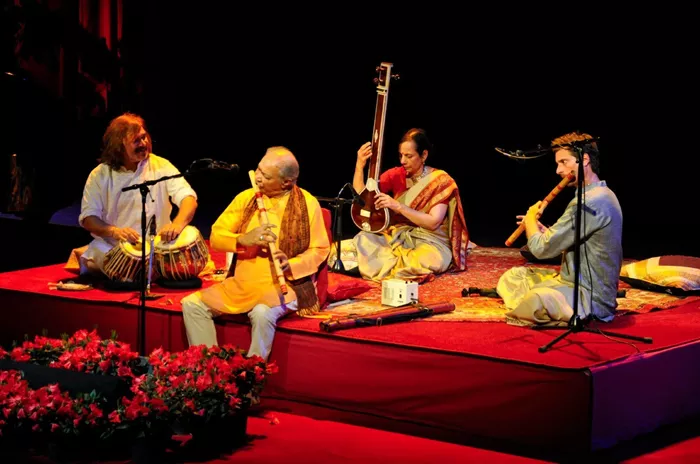At the age of 40, Ludwig van Beethoven was deaf, yet he composed the iconic Symphony No. 9, a masterpiece that shaped classical music for centuries. His ability to imagine each instrumental layer without physically hearing them highlighted how music’s essence lies in its fundamental components.
Today, these components are called “stems”—separate elements such as vocals, instruments, and percussion that form a complete composition. While all music genres assemble stems uniquely, Indian classical music presents a challenge due to its intricate, seemingly similar-sounding instruments, making isolation difficult.
The Birth of Sur: An AI-Driven Stem Splitter
Existing stem-splitting tools primarily cater to Western music, leaving Indian classical music underserved. This gap led 19-year-old Shanit Ghose to develop Sur, an AI-powered stem splitter and sample library designed specifically for Indian classical music. Unlike generic tools, Sur accurately captures the genre’s nuanced layers, enabling modern producers to incorporate traditional elements seamlessly.
“My vision from day one has been to guide the music industry toward sampling niche genres. Indian classical music is a goldmine of instruments and variations,” Ghose tells YourStory.
A Passion for Music and AI
Ghose, an alumnus of Oberoi International School in Mumbai, has been deeply immersed in music since childhood. He started playing the piano at four and later switched to guitar at ten. While leading a high school rock band, he struggled to find backing tracks that excluded original guitar parts. Frustrated by incomplete or low-quality available tracks, he manually removed guitar sections using audio software, which sparked his interest in stem isolation.
Inspired by his aunt, a Bollywood music composer, Ghose ventured into music production using Logic Pro X. During his experiments with Indian classical samples, he realized that no existing tools could effectively isolate stems from Indian classical recordings, making it difficult to integrate these sounds into new compositions.
“That limitation affects any producer or DJ wanting to incorporate Indian classical elements into their work. Most stem splitters are trained on pop, rock, or mainstream Western music, which don’t handle Indian classical well. So I thought, ‘Why not build my own tool?’ That’s how Sur was born,” Ghose explains.
Building an AI Model for Indian Classical Music
Launched in early 2024, Sur utilizes a proprietary AI algorithm trained on over 350 Indian classical music tracks. It leverages advanced deep learning models for frequency separation and features a curated sample library from independent artists. Ghose used Demucs, a deep-learning-based source separation tool, to process tracks and isolate instruments.
“To build the model, I had to create a training dataset from scratch. I manually separated 350 songs, teaching the AI to recognize Indian instruments like the sitar and tabla instead of Western instruments like the guitar or piano. Since these instruments operate on different frequency ranges, extensive fine-tuning was needed to optimize the model,” he says.
Beyond stem isolation, Sur offers a curated sample library, collaborating with independent artists to allow their work to be sampled while giving them access to diverse sounds for their own projects.
Expanding AI Expertise
Ghose previously worked as a Voice Activity Detection Engineer at Sarvam AI, an artificial intelligence startup, for several months. His work there involved training AI models to distinguish between male and female voices, a skill he later applied to instrument separation in Sur.
“I adapted similar techniques used in voice recognition to distinguish Indian classical instruments. Over time, I fine-tuned the system to accurately identify and separate different sounds,” he explains.
Industry Recognition and Future Plans
The global music production software market is valued at approximately $7.5 billion, growing at a CAGR of 9.1%. In India, the music software market is projected to reach $500 million by 2029. While currently bootstrapped, Sur is in talks for seed funding, with renowned Indian music composer and singer Salim Merchant expressing interest in supporting the initiative.
“I presented Sur to Salim, and we reviewed every detail together. He provided valuable feedback and offered to help scale the project by sharing it within his network,” Ghose says.
Merchant praises Sur as a groundbreaking tool for music producers worldwide. “Shanit’s innovation blends Indian classical music with modern technology. Its precise stem isolation is a game-changer for producers globally. I believe in its potential and am excited to support its journey,” Merchant tells YourStory.
The platform follows a fair revenue-sharing model, ensuring that contributing artists earn royalties each time their samples are used. Future plans include partnerships with platforms like Logic Pro, Ableton, and FL Studio, as well as integration with global music education programs to establish Sur as the go-to tool for Indian classical music internationally.
While local tools like Spleeter lack ICM-specific capabilities, global platforms like Splice and Tracklib focus on general music sampling without catering to cultural nuances. Sur aims to fill this gap.
Ghose is also looking to expand sampling capabilities to other niche genres, such as Russian and Italian music. Currently, Sur has 100 users, with a target of onboarding 10,000+ users within a year.
“This model not only helps producers explore new sounds but also allows independent artists to gain recognition and steady income. As more users join, Sur will continue to scale, empowering niche musical genres globally,” Ghose says.
Related Topics

